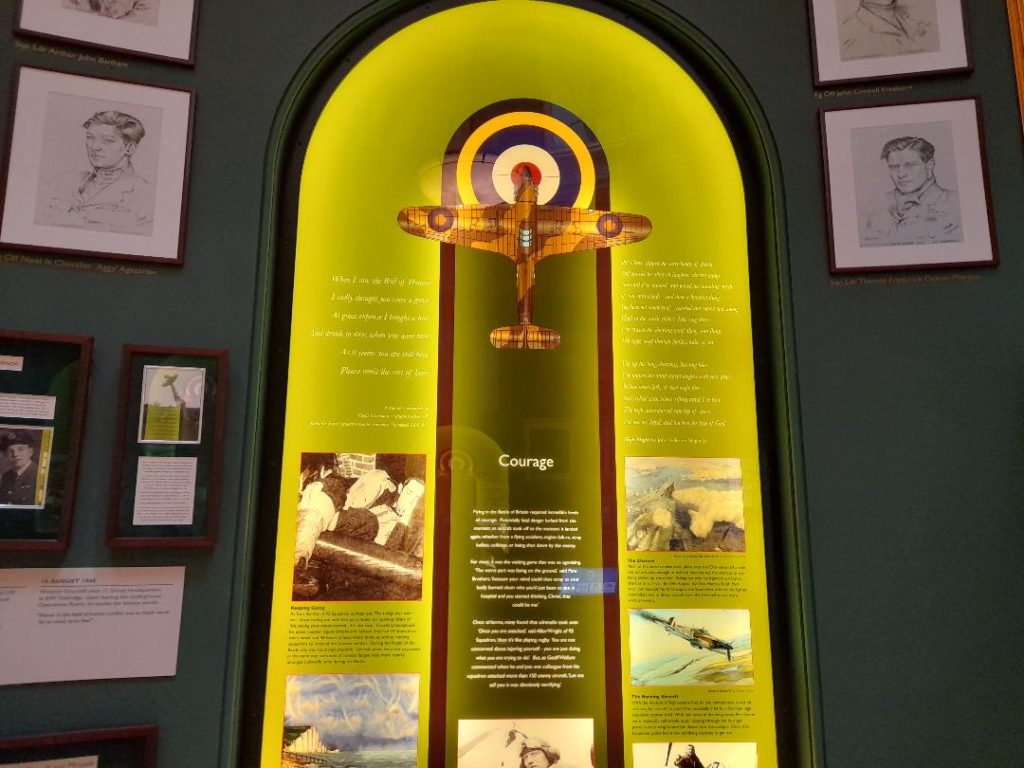Bentley Priory Museum is undoubtedly one of greater London’s hidden gems. Located near Bentley Priory nature reserve, this grade II* listed mansion was the Headquarters for Fighter Command during World War 11. Acting as an intelligence filter on incoming air raids, RAF Bentley Priory helped us win the Battle of Britain and maintain the free world. Intrigued, I took an afternoon off to find out more.

What is the history of Bentley Priory?
Founded in 1170, Bentley Priory’s first residents were Augustinian Friars who lived there until the dissolution of the monasteries in the 1500s. In 1766, the estate was sold to James Duberly. James dismantled the original priory and built the first part of the present building on a ridge some distance from the original site.
Later in 1788, John James Hamilton, the 9th Earl of Abercorn bought the estate and commissioned Sir John Soane to refurbish it in “a more sumptuous and lavish manner.” The improvements included the addition of stained-glass windows and the rotunda room. Dowager Queen Adelaide, (Queen Victoria’s aunt) lived at Bentley Priory during the last year of her life from 1848-1849. The site was later sold and converted into a hotel in 1882 before its next transformation into a private girls’ school in the early 1920s.
After lying dormant for a few years, the RAF bought the site in 1926 and a decade later in July 1936, RAF Fighter Command was created. The RAF occupied the mansion house and grounds until 2008.
Where is Bentley Priory Museum?
Bentley Priory Museum is located in Stanmore in the London borough of Harrow in north west London – (postcode HA7 3HT), London Travelcard zone 6. The nearest tube station is Stanmore at the end of the northbound Jubilee Line. From Stanmore tube station, take the 142 bus to Watford Junction and jump off at Heathbourne Road – a 10 minute journey. It takes 50 minutes to walk from Stanmore tube station to RAF Bentley Priory.

What are the Bentley Priory Museum opening times?
From October to February, the museum is open on Wednesdays, Fridays & Saturdays from 10am – 4pm with the last admission at 3pm. From March to September, the last admission changes to 4pm with the Museum closing at 5pm.
Do you need to book in advance to visit RAF Bentley Priory?
There is no need to book in advance and tickets can be purchased at the reception desk on arrival. The entry cost is £8.00 for adults and £4.00 for children with special concessions for the over 60’s, students and those on benefits.
What are the highlights of RAF Bentley Priory?
You will need around two and a half hours to visit RAF Bentley Priory Museum properly. The rooms and exhibits are divided into three categories. “The Many” exhibits are dedicated to those who worked in the background operations. “The Few” exhibits are dedicated to the fighter pilots and “The One” exhibits refer to Sir Hugh Dowding, Fighter Command’s, Commander in Chief.

The Filter Room – dedicated to The Many
Named after Fighter Command’s Commander-in-Chief Sir Hugh Dowding, the Dowding System was developed over three years to bring technology, ground defences and fighter aircraft together into a combined defence system. This system not only controlled the fighter force but also the searchlights, anti-aircraft guns and barrage balloons.
In the recreated Filter Room, men and women from the RAF and WAAF (Women’s Auxiliary Air Force) toiled tirelessly under relenting pressure to filter information about raids from radar station along the length of the east coast of Britain before sending it on to the Operations Rooms -also at RAF Bentley Priory.
The sheer magnitude of the task at hand can be witnessed on the Filter Room map where “filterers” would endlessly move plastic counters across elaborate grids. You can listen to a very informative explanation of the coding involved via headphone sets in the room. As another fascinating personal touch, there are also recorded interviews with some of the women who were filterers at Bentley Priory discussing the rigours of the job.

The Rotunda Gallery – dedicated to The Few
The light-filled rotunda gallery is dedicated to the stories of the courageous fighter pilots referred to as “The Few” in Winston Churchill’s famous quote. Here you can learn about their daily routines including the agonising waits before being called into action. The room features photos and heart-wrenching letters from the fighter pilots to their families. And in some cases, the letters are from strangers informing families of their son’s death. Five hundred and forty-four aircrew were killed during the Battle of Britain and a further four hundred and twenty-two aircrew were wounded.
Audio-visual film – the One behind the Few
Another undoubted highlight of the visit is an award-winning 10-minute audio-visual film which explains in more detail about Sir Hugh Dowding’s role at Bentley Priory. The film superimposes wartime images against the backdrop of Sir Hugh Dowding’s office at Bentley Priory while also drawing on theatrical touches such as doors swinging open and shut during the broadcast. The overall visual and auditory effects are captivating and it’s not surprising the film won an award.

Other highlights of RAF Bentley Priory
There is so much to uncover in RAF Bentley Priory – from the beautiful stained-glass windows through to the opulent Adelaide Room and the sunken Italian gardens at the back of the mansion. There is also a fantastically chintzy tearoom at the Bentley Priory cafe where you can grab a cup of tea before taking a photo or two beside the full-scale model aircraft outside the museum entrance.
It’s hard to believe that I only live a few miles from the nerve centre for the Battle of Britain and it still sends a shudder down to spine to think how differently things could have turned out without “the one” “the few” and “the many” that we owe our freedom to today.
More information on the museum can be found here.
